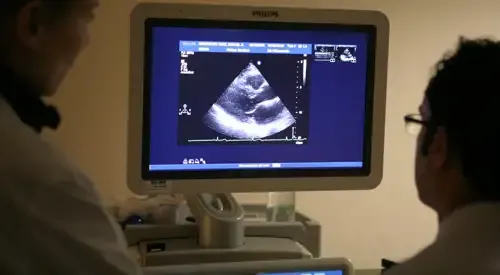Acute Ischemia Syndrome
"The three fundamental causes capable of producing it are thrombosis, embolism and trauma".
DR. JOSÉ IGNACIO LEAL
PERSON IN CHARGE. VASCULAR SURGERY SERVICE
What is acute ischemia?
Acute ischemia is the abrupt suppression of blood supply to a certain territory as a result of the obstruction of blood flow in one or more arteries.
Within acute ischemia, two entities can be distinguished: thrombosis and embolism.
It is frequent in patients with previous symptomatology of pain in the extremities, coinciding with the march (intermittent claudication) and it is much more frequent in patients with atherosclerotic risk factors; men over 60-70 years old with history of arterial hypertension, smokers and with high cholesterol figures.
It is also frequent in patients with certain cardiac arrhythmias and/or heart valve diseases, especially mitral stenosis, as well as in carriers of mechanical valves.

What are the symptoms of acute ischemic syndrome?
Independently of the cause that produces it the acute ischemia is a picture of pain of sudden establishment accompanied by coldness and pallor. The pain is very intense and does not respond to the usual painkillers.
It can happen in any territory but the most frequent thing is that it happens in the extremities and, mainly, in the inferior extremities.
In very evolved pictures it can appear absence of pulse, lack of sensitivity, paralysis and even frank gangrene.
The most common symptoms are:
- Intense pain.
- Coldness.
- Pallor.
Do you have any of these symptoms?
You may have an acute ischemic syndrome
What are the causes of acute ischemia?
The three fundamental causes capable of producing it are:
- Acute arterial thrombosis is the obstruction of a blood vessel by a clot formed in the same place where the obstruction occurs, mainly due to the atherosclerotic involvement of its wall.
- Embolism: is the sudden obstruction of a vessel, generally healthy, by a clot formed in another place and dragged there by the bloodstream. Most frequently, the embolus forms in the heart and is pumped into the bloodstream through which it "navigates" until it is impacted in an artery smaller than its diameter.
- Arterial trauma causes ischemia of the territory affected by the injury of the vessel that provides it with the necessary blood.
What is your prognosis for acute ischemia?
It will depend on each case but, in general terms, the most important prognostic factor is the time between the onset of symptoms and the start of treatment, which should not exceed six hours.
Highly developed cases can lead to amputation of the limb and even death due to associated complications.
How is acute ischemia diagnosed?

In most cases it is enough for the doctor to see the patient and explore him/her to reach the diagnosis of acute ischemia.
When the clinical history is taken, a history of atherosclerotic risk (smoking, hypertension, diabetes or hyperlipemia) will be recorded, which will help to identify the condition as probable thrombosis or embolism. It will also be necessary to inquire about cardiological history and previous treatments.
To find out whether it is a thrombosis or an embolism, it will almost always be necessary to perform complementary tests, including an electrocardiogram, doppler and arteriography.
How is acute ischemia treated?
Treatment will depend on the patient's condition and the results of diagnostic tests and may be medical and/or surgical.
In the case of an embolism, the treatment is usually surgical and consists of removing the clot from the affected vessel (embolectomy).
If the cause of the problem is a thrombosis, the situation can be managed initially with medical treatment (analgesics, anticoagulants, fibrinolytics, hemorrheological), being necessary in most cases a subsequent surgical intervention (endarterectomy, angioplasty, "bypass").
Where do we treat it?
IN NAVARRA AND MADRID
The Vascular Surgery Service
of the Clínica Universidad de Navarra
The Vascular Surgery Service of the Clinic has the latest technology for the diagnosis, treatment and surgery of vascular pathologies. Our wide experience, framed in the quality care environment of the University of Navarra Clinic, allows us to offer the patient the most effective and innovative treatments.
We have an operating room specialized in vascular surgery, equipped with advanced equipment for the surgical treatment of the most important vascular diseases.
We are pioneers in endovascular brachytherapy, localized radiotherapy to treat tumors, which has been practiced in the world on very few occasions.
Diseases we treat
- Diseases of the aorta
- Carotid diseases
- Chronic venous insufficiency (varicose veins)
- Ischemia of lower extremities
- Varicose ulcers

Why at the Clinica?
- En menos de 24 horas podemos realizar las pruebas necesarias para establecer el diagnóstico y el planteamiento del tratamiento.
- Área de Flebología pionera en España en el tratamiento de varices con microespuma.
Our team of professionals
Specialists in Vascular Surgery with experience in the treatment of acute ischemia
Cardiovascular Checkup
ICAP
INTEGRATED CARDIOVASCULAR
ASSESSMENT PROGRAM
A new approach to cardiovascular risk
The only checkup that incorporates the latest diagnostic imaging technology to accurately quantify your risk of stroke and myocardial infarction.
Thanks to the exclusive dedication of our professionals, we are able to perform the ICAP checkup in less than 48 hours with a highly accurate diagnosis.



